What Core Can I Say? - Part 1
It's time for me to start sharing some card-by-card stories. As this wasn't a set I was on the design team for, I'll be talking through cards from more of a head designer perspective. Also, I've decided to focus on all the legendary items in the set, the seven planeswalkers, the eleven creatures, and one noncreature artifact.
Ajani, Strength of the Pride
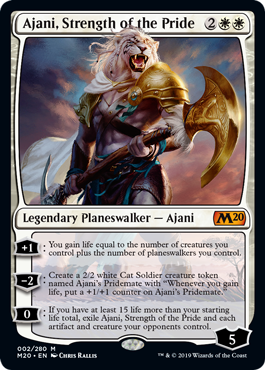
This is a core set, so we wanted a cycle of monocolored planeswalkers. There actually weren't a lot of choices for mono-white. Only seven Planeswalkers have ever appeared on a mono-white card: Ajani, Elspeth, Gideon, Nahiri, Serra, Teyo, and The Wanderer. Elspeth, Gideon, and Serra are dead. While Nahiri started base white, she's shifted into strongly being red-white. Teyo and The Wanderer are both brand new (being introduced in War of the Spark), which meant they weren't even an option when the set was in design as sets next to each other overlap for most of their design. There are a bunch of other Planeswalkers that have white in them (Aminatou, Dovin, Estrid, Huatli, Kaya, Narset, Sorin, Tamiyo, Teferi, and Venser), but none of those are really base white. That left Ajani. While Ajani is now a green-white planeswalker, he's still base white, so we use him in mono-white from time to time (Planeswalkers don't have to have all their colors in a printing, but we don't print them out of their base color).
There have been a number of Ajanis, so he has a strong mechanical identity. Ajani's power suite is that he has the ability to heal or boost others, but not himself. Usually, that translates into a few things:
- He can cause you to gain life
- He can temporarily or permanently (with +1/+1 counters) boost creatures
- He can temporarily grant abilities to creatures
- He can boost other planeswalkers by giving them loyalty counters
- He can summon Cats; sometimes they're also Soldiers
- He can get rid of creature threats (although, usually as a negative loyalty ability, as it's not something he prefers to do)
In addition, we like core set planeswalkers to give the player some direction in building a deck with them. It also helped us deal with having so many planeswalkers in Standard because of War of the Spark. More focused planeswalkers require more focused deck choices. For this Ajani, the message was "play with creatures and planeswalkers." The planeswalker part comes from the fact that this set is coming out right after War of the Spark with its strong planeswalker theme. His first ability is communicating this message and tying it into life gain. Life gain is nice as it helps Ajani protect you, the player. (You are a Planeswalker, after all.)
The second ability is a common one for planeswalkers: making a creature token. Creature tokens work well because they serve several functions. One, they help protect the planeswalker from attack. Two, they give the player the ability to be aggressive and win the game. Three, creature tokens are pretty flavorful. We always like to make the abilities synergistic, so the idea with this ability isn't just to make a Cat creature token but a specific creature associated with Ajani—Ajani's Pridemate. The card just appeared in War of the Spark (with its tweaking of the ability, removing "may"), so it would be fresh in players' minds. Also, the life-gain trigger plays nicely with Ajani's first ability. Notice how the synergy works both ways. The first ability wants more creatures, which the second ability does, and the second ability wants life gain, which the first ability does.
Ajani's ultimate is different in that instead of requiring a threshold of loyalty, it requires a threshold of life. This plays nicely with the first two abilities. Note that it says "your starting life" so it can work in formats that start with more than 20 life (such as Commander). Because it's not tied to loyalty, the effect requires you to exile Ajani so that you can only do it once. My best guess on the ability is it started just affecting creatures, but artifacts got added in for some play design reason. The lack of a loyalty-based ultimate also makes it easier to use the negative loyalty creature token–making ability.
Atemsis, All-Seeing
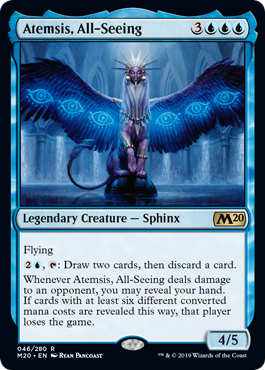
Atemsis is part of our cycle of iconic legendary creatures. The goal with this card was to make a mono-blue legendary Sphinx that both felt like a Sphinx and was a fun card to build around. Sphinxes were chosen as the blue iconic creature because they are focused on information. The creature type originally comes from a story in Greek mythology where travelers were forced to answer a riddle from the Sphinx or be killed. To capture a sense of Sphinx-ness, we tend to like to have our Sphinxes interact with information in some way. In addition, we like them to seem like a puzzle that needs to be solved. Atemsis does well in both areas.
First off, Atemsis flies because all Sphinxes fly. Next, it has a card-drawing ability combined with a looting ability. The reason for this is that we like Sphinxes forcing the player to think. The draw plus loot makes every interaction force the player to think through not just what is going on during the current turn, but think ahead to what will be going on in future turns. The last ability plays into the idea of creating a puzzle. Atemsis can help win you the game, but you have to plan ahead about how you're going to accomplish the task laid out in front of you.
The ability makes the opponent lose the game instead of having you win it because we're thinking about multiplayer play. In two-player play, there's no difference, but the dynamic in multiplayer play is better if you don't just beat everyone in one fell swoop. This requires you to be a bit more strategic and think ahead to how the politics will play out as you eliminate one player.
Chandra
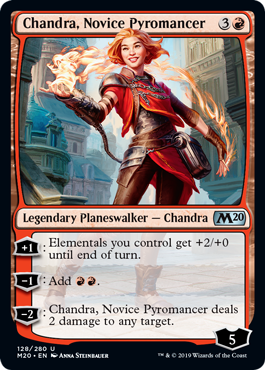
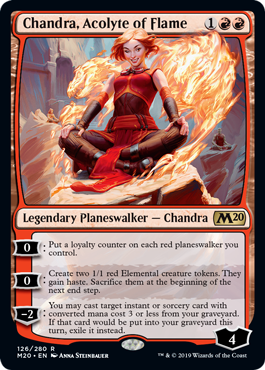
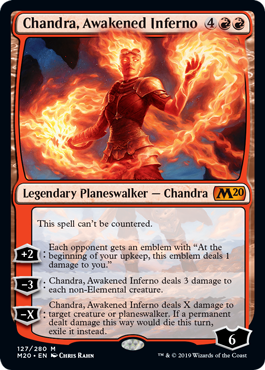
The choice for the red planeswalker was an easy one as it was one of the first decisions made about the set. Every core set likes to have a face, and for Core Set 2020 that was going to be Chandra. The challenge for Chandra in this set was we weren't just making one Chandra but three—one at uncommon, one at rare, and one at mythic rare. The decision was to have each of them with a normal three loyalty abilities, just crafted to fit the rarity it was designed for. (The mythic rare does have one more thing beyond that.)
Prior to Core Set 2020, we'd made ten Chandra planeswalker cards (this includes Planeswalker Deck cards). Obviously, her power suite is pyromancy. Here's the various ways we've tapped into that mechanically:
- Direct damage (any and all kinds, to any target of any size; Chandra is the premier damage-dealing Planeswalker)
- Temporary mana production (to help you play your direct-damage spells)
- "Impulsive drawing" (aka exiling cards from top of library that you can play for a short duration, most often the turn; impulsive drawing in the modern era first appeared on a Chandra planeswalker, by the way)
- Casting instants and sorceries from your graveyard
- Copying instants and sorceries
- Rummaging (discarding cards and then drawing)
- Creating Elemental creature tokens (usually with haste and exiled at end of turn)
We'll begin with her uncommon—Chandra, Novice Pyromancer. We wanted it to be directional and useful in Limited. The set had an Elemental theme (in red, blue, and green), so it made sense for her first ability, the only plus ability, to tie into that. She hasn't pumped creatures' power before, but as it's limited to Elementals that felt in flavor. Note that we tend to flavor the card for what makes sense—her boosting fire Elementals with her pyromancy—but allow a wider interaction with all Elementals as it leads to better gameplay. Her first negative loyalty ability is mana production and her second, and slightly larger, negative loyalty ability is direct damage, both things squarely in her wheelhouse. The second and third ability were designed to be pretty basic, so even in a non-Elemental deck, you'd want to run the card.
Next, we move onto her rare—Chandra, Acolyte of Flame. Her first ability is a new one, one specifically meant to interact with her other versions. One of the goals of making three Chandras was enabling a Chandra-themed deck in Standard. My guess is they went back and forth on this, putting loyalty counters on Chandras or red planeswalkers, but ended up with the latter for the same philosophy as her boosting Elementals. The flavor is she's using her flame power to help other fire-based characters (such as herself or Jaya), but the extra flexibility will lead to better gameplay and allow other red planeswalkers in your Chandra deck. Her second and third loyalty abilities are straight from abilities listed above. Instead of one temporary larger Elemental (such as a 3/1), she's making two 1/1 Elementals. I assume this was done to create more synergy with the Elemental tribal stuff in the set (such as the first loyalty ability on the uncommon). Her last ability (and note that neither the uncommon nor rare versions have an ultimate) allows her to cast cheap instants and sorceries out of your graveyard. Thematically, these will be direct-damage spells.
Finally, we get to her mythic rare version—Chandra, Awakened Inferno. (Notice by the way that each version moving up in rarity shows her later in life, more in control of her pyromancy and with more visible fire.) Her mythic rare actually has four abilities, one of which is a static ability. War of the Spark added this tool for planeswalkers, and we use it here. This is a simple ability to keep it from being countered as blue is the enemy of red. The first, and only, positive loyalty ability sets the opponents on fire. This is done with emblem technology. To help with multiplayer play, the ability gives an emblem to each opponent. Her second ability is a direct-damage ability, but hitting all creatures rather than just one creature. It says non-Elemental for two reasons. One, it's flavorful. Creatures made of fire are immune to fire, as are creatures made of water. Two, it allows you to build around the card. If you play a lot of Elementals (which is thematic for Chandra), they're immune to her fire. Her ultimate is basically an X-spell for creatures and planeswalkers. It has some Disintegrate flavor in that if it kills creatures, they get exiled instead of going to the graveyard, implying that they've been completely destroyed by the fire. There's no reanimating them.
The three Chandras were designed to each have their own flavor and focus, yet all want to be played together in the same deck. For example, each has a tribal Elemental component. Her uncommon boosts Elementals, her rare makes Elementals, and her mythic rare kills everything but Elementals. Her uncommon can give you mana so the rare can cast cheap spells from the graveyard. The rare can grant loyalty counters so that the mythic rare can do extra damage. The three cards are made to feel like extensions of Chandra, but come together to make a total Chandra package.
Chandra's Regulator
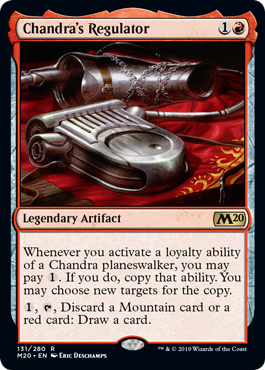
Speaking of Chandra, this is the only legendary card that is neither a creature nor planeswalker. Chandra is the face of the set, so it seemed only appropriate to give her a legendary item. The question was what should it be? We'd already done Jaya's Goggles (Pyromancer's Goggles in Magic Origins), so Chandra's goggles seemed like a retread. How about her regulator, the device her father created to help her deal with her budding pyromancy?
The design team knew they wanted it to play nicely with the three Chandras, so the first ability was designed to directly interacted with Chandra planeswalkers. It allowed you to essentially use a Chandra ability twice. The only gating of the ability is mana, so if you have enough mana, you can use it on every Chandra you have on the battlefield. The second ability was to make sure the card was relevant, even if you haven't drawn your Chandra card yet. In fact, it will help you find your Chandra card so you can cast it. The ability allowed you to discard a red card or a Mountain so that every card would be useful in a mono-red deck. (Beginners also get confused about whether a Mountain is red, and this makes the point moot.) Hopefully, this is one of the cards that helps make the Chandra deck a viable thing to play in Standard.
Drakuseth, Maw of Flame
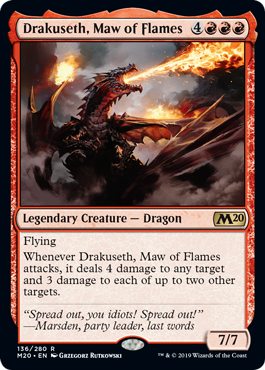
Designing iconic legendary Dragons is tricky, not because the flavor isn't well defined, but because we've done it so many times. (For example, we've created nine legendary Sphinxes before Core Set 2020. In contrast, we've made 55 legendary Dragons.) Drakuseth has a breath weapon, something we've done many times, but this version has a small twist. Rather than deal damage to a single target, Drakuseth delivers his damage to three different targets. The damage isn't all the same, though. One creature gets hit for 4, and two others get hit for 3. This gives the feel that he's dividing up his flame attack, focusing on one creature and hitting the others with splash damage. Also, for subtle aesthetics, the two numbers that appear in the rules, 4 and 3, add up to 7, Drakuseth's power and toughness.
Gargos, Vicious Watcher
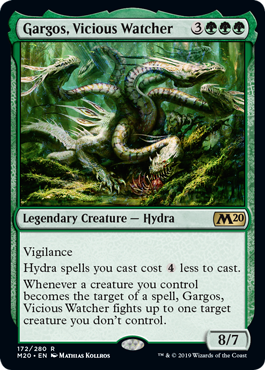
When I was researching the write-up for this card, I went and looked at how many legendary Hydras there were. I could name three off the top of my head, so I assumed there would be a bunch more. Nope. Only one more—there are only four. Interestingly, only one (Polukranos) is mono-green. What this meant was Gargos had a lot of room to play.
Early on, we tended to play up the multiheaded-ness of Hydras, so most of them were X spells or had some mechanic that added heads as they took damage. Eventually, we realized that was a bit narrow and we started broadening our designs. Gargos was made mostly as a Hydra enabler and a way to protect creatures in a green manner.
For starters, Gargos is big. He's 8/7 for six mana. He also has vigilance to allow him to be both offensive and defensive. His second ability is a Hydra-enabling ability which makes all Hydras cost 4 less to cast. As Hydras are most often defined by their size, the four mana will be effective on most Hydras. Also, it plays nicely with X spells as it basically turns your X into X+4. His last ability was a green attempt at protecting your creatures. Rather than actually protecting creatures by stopping effects (that's white's way), Gargos intimidates the opponent to not want to cast the spell in the first place. "Mess with my creature and Gargos is going to kill one of yours."
I'm happy that Gargos feels very Hydra-y while having a design that plays differently than a lot of other Hydras. I'm interested to see what you all do with it.
Golos, Tireless Pilgrim
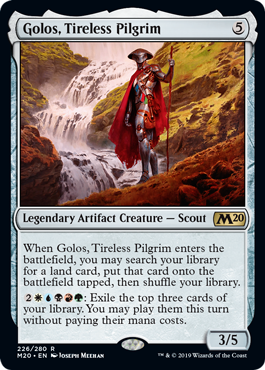
Golos is a perfect example of the impact Commander is making throughout the design of all our sets these days. As more and more players are playing Commander, we're trying to make sure that every set has some tools for the format (as well as for Brawl). Golos was designed as a simple five-color Commander that helps your mana, something most five-color Commander decks need. His activated ability both grants Golos a five-color identity and gives him a powerful ability for the late game. The effect plays off the top of the library rather than tutoring to increase the variance of the play. It's much more fun for you to not know what is coming and be surprised than to have every game play out the same because you always go and get the same card.
Living Legends
That's all the time I have for today. I hope you've enjoyed part one of my look at all the legendary cards of Core Set 2020. As always, I'm eager for any feedback on today's column, on any of the cards I discussed, or about the set itself. You can email me or contact me through any of my social media accounts (Twitter, Tumblr, and Instagram).
Join me next week for part two as I talk about the rest of the legendary cards.
Until then, may one or more of these legendary cards find a way into one of your decks.
#649: MagicFest London
#649: MagicFest London
So, I went to England for MagicFest London and Mythic Championship II. This podcast talks all about my trip.
#650: War of the Spark Cards, Part 1
#650: War of the Spark Cards, Part 1
36:49
This is part one of a five-part series on card-by-card design stories from War of the Spark.
- Episode 648 Working on the Road
- Episode 647 Designing Library Effects
- Episode 646 Seeing the World

